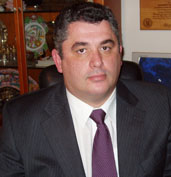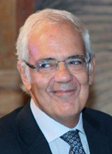Abstract:
The state of the art of robotic manipulation is still rather far from the human dexterity in the execution of complex motions such as, for example, in dynamic manipulation tasks. Dynamic manipulation is considered as the most complex category of manipulation requiring ad-hoc controllers and specialized hardware. In case of non-prehensile manipulation or non-rigid objects, the task of dynamic manipulation becomes even more challenging. This reduces the opportunities for wide adoption of robots within human co-habited environments. This talk presents the results achieved within the RoDyMan project related to perception, planning and control strategies for robotic non-prehensile manipulation. The project aims at advancing the state of the art of non-prehensile dynamic manipulation of rigid and deformable objects to further enhance the possibility of employing robots in anthropic environments. The final demonstrator of the RoDyMan project will be an autonomous pizza maker. The lessons learned so far are highlighted to pave the way towards future research directions and critical discussion.
Bio:
Professor Bruno Siciliano is Director of the Interdepartmental Center for Advances in RObotic Surgery (ICAROS), as well as Coordinator of the Laboratory of Robotics Projects for Industry, Services and Mechatronics (PRISMA Lab), at University of Naples Federico II. Fellow of the scientific societies IEEE, ASME, IFAC, he received numerous international prizes and awards, and he was President of the IEEE Robotics and Automation Society from 2008 to 2009. Since 2012 he is on the Board of Directors of the European Robotics Association. He has delivered more than 150 keynotes and has published more than 300 papers and 7 books. His book “Robotics” is among the most adopted academic texts worldwide, while his edited volume “Springer Handbook of Robotics” received the highest recognition for scientific publishing: 2008 PROSE Award for Excellence in Physical Sciences & Mathematics. His research team got 18 projects funded by the European Union for a total grant of 10 M€ in the last ten years, including an Advanced Grant from the European Research Council.
Konstantinos J. KyriakopoulosControl Systems Laboratory |
 |
Title:
The Quest for Provable Robotic Motion Planning |
Abstract:
Endowing robots with decision-making capabilities that enable them to autonomously navigate is a problem addressed as early as their conception. The robot class (fixed base or mobile platform), the operational workspace (free or clattered with obstacles) and the type of perception (global or local sensing) are factors that contribute to the complexity of the problem at hands. Furthermore, when multiple autonomous robotic systems are required to operate inside the same workspace, additional restrictions stemming from communication constraints and available computational resources determine the coordination scheme to be employed, which can be either centralized or decentralized, even in the case of non-antagonistic tasks. During the last 20 years, in a series of developments, we have addressed issues of motion planning for several robotic platforms (ground, underwater, aerial) subject to various kinematic constraints, for every combination of the aforementioned classes of environment, sensing and cooperation character. Our quest has been centered on designing provably correct control laws as well as stressing out their limitations. Extending Navigation Functions principles for the non-holonomic and multi-agent cases, combining vector fields with viability principles for systematic non-holonomic design, integrating Harmonic Maps and Potential Fields with our framework, addressing arbitrarily shaped configuration spaces, etc. are some of the approaches to be overviewed. Applications in single robot or multi-robot cooperative mobile manipulation (ground and underwater), centralized and decentralized multi- and micro-robot cooperative control, air-traffic conflict resolution, etc. will be also presented to discuss the associated performance issues, limitations and indications for strategic considerations on the future of robot motion planning algorithms.
Bio:
He was born in Athens, Greece in 1962. He received the Diploma in mechanical engineering with Honors from the National Technical University of Athens (NTUA), Greece, in 1985 and the MS and Ph.D. in Electrical, Computer & Systems Engineering from Rensselaer Polytechnic Institute (RPI), Troy, NY in 1987 and 1991, respectively. From 1988 to 1991 he did research at the NASA Center for Intelligent Robotic Systems for Space Exploration. Between 1991-93 he was an Assistant Professor at the Electrical, Computer and Systems Engineering Department of RPI and the New York State Center for Advanced Technology in Automation and Robotics. Since 1994 he has been with the Control Systems Laboratory of the Mechanical Engineering Department at NTUA, Greece, where he currently serves as a Professor and Director of the Post-Graduate Program on „Automation Systems”. His current interests are in the area of Nonlinear Control and Embedded Systems applications in Sensor Based Motion Planning & Control of multi-Robotic Systems: Manipulators & Vehicles (Mobile, Underwater and Aerial). He was awarded the G.Samaras award of academic excellence from NTUA, the Bodosakis Foundation Fellowship (1986-1989), the Alexander Onassis Foundation Fellowship (1989-1990) and the Alexander Von Humboldt Foundation Fellowship (1993). Dr. Kyriakopoulos has published more than 320 papers to journals and refereed conferences; he is Specialty Chief Editor for „Frontiers in Robotics and AI” and he serves in the editorial committees of a number of journals and conferences, while he has served as an administrative member of a number of international conferences. He has acted as PI in 35 R & D projects, half of which funded by the European Commission. He is an IEEE Fellow.
Francois ChaumetteIRISA, Inria Rennes-Bretagne Atlantique |
 |
Title:
Geometric and end-to-end robot vision-based control |
Abstract:
As for humans and most animals, vision is a crucial sense for a robot to interact within its environment. Vision-based robot motion control, also named visual servoing, is a general approach to close the perception-action loop. It has given rise to an incredible amount of research and successful applications from the creation of the fields of robotics and computer vision several decades ago. The aim of this talk is to provide a comprehensive state of the art on the basic concepts, methodologies, and applications. In a first part, the traditional approach based on geometric visual features, such as image points, image moments, or camera-object pose will be described. The more recent end-to-end approach that directly uses the image content without any image tracking nor matching process will be also considered, providing a link to CNN modern methods that use the same inputs.
Bio:
François Chaumette, IEEE Fellow, is an Inria senior research scientist at IRISA in Rennes, France, where he lead the Lagadic group since 2004. He received the M.Sc. (eng.) degree from „Ecole Nationale Supérieure de Mécanique”, Nantes, in 1987 and a Ph.D. in computer science from the University of Rennes in 1990. His research interests lie in the area of robot vision, mainly visual servoing and active perception. He has published over 250 journal or conference papers, with the 2002 Best IEEE Transactions on Robotics and Automation Paper Award. He has served on the technical program committee of the main conferences in computer vision (ECCV, CVPR, ICCV) and robotics (ICRA, IROS, RSS). He has been Associate Editor of the IEEE Transactions on Robotics (2001-2005) and Funding Senior Editor of the IEEE Robotics and Automation Letters (2015-2018). He is currently in the Editorial Board of the Int. Journal of Robotics Research, and Senior Editor of the IEEE Transactions on Robotics.


